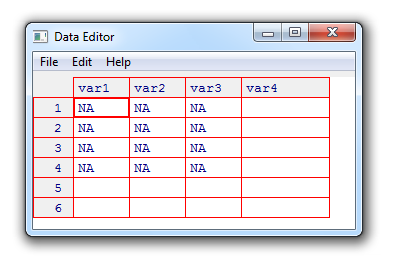
I have produced this image with a variation of this script. Unfortunatly, I lost the script that created the picture above, but this script sort of comes close.

I have produced this image with a variation of this script. Unfortunatly, I lost the script that created the picture above, but this script sort of comes close.
In the preface, I found the following quote, to which I wholeheartedly agree:
data.entry(), it's easy to visually fill (small) matrices in r.
Let's see it in action. First, I create a 4x3 matrix:
The matrix is created with the cells' values being NA Now, in order to assign values to these cells, I use

And here's how they looked after my editing them just before I used File > Close:

Back in the shell, the matrix has indeed changed its values:
Pretty cool, imho.
If the insert statement fails, is the sequence still incremented?
Let's try it with a test. The table:
After running this anonymous block, the table contains:
netxtval is "wasted" if the insert statement fails.
CLOB:
With Perl and DBD::Oracle, the CLOB in the table can be filled like so:
A CLOB can be selected like so:
Here's a simple perl script that demonstrates its use:
The code is on github: OracleTool.pm and UtlFile.pm.
NLS_LANG on Windows in SQL*Plus.
First, it can be verified if the environment variable NLS_LANG is set:
SQL*Plus will answer with either something similar to
In the first case, the environment variable is set and its value, as displayed by the echo command is the value for NLS_LANG.
If the variable is not set, that is in the second case, the following trick allows to determine its value none the less:
There are again two possibilities how SQL*Plus will react. Either
In the first case, the value for NLS_LANG is set in the Windows registry (to the value between [ and ]). In the second case, NLS_LANG is not even set in the Windows registry.
Incidentally, this seems to be achieved much easier like so
A quick google search brought me to the always helpful superuser.com site, particularly this answer.
In short, multiple PDFs can be joined so
DBMS_DATAPUMP can create SQL files from a schema so that these files can later be run to re-create the schema.
This is described in Oracle Note 1519981.1: How to Generate A SQL File Using The DBMS_DATAPUMP_API?. Unfortunately, the note does not explicitely state that the creation of such an sql file consists of two steps, first the schema has to be dumped ordinarly, then, the dumped file has to be turned into the desired SQL file.
Here are the steps to create such an SQL file.
My question on dba.stackexchange.com
FROM_SCHEMA_A) that I need to clone on the same database. So, the cloned schema will go by another name, in my case by TO_SCHEMA_A).
In order to make things a bit more complicated, FROM_SCHEMA_A references objects in another schema (named
SCHEMA_B). This other schema won't be cloned.
Here's the definition for the SCHEMA_B schema. It consisists of one table only:
Since FROM_SCHEMA_A references this table, it needs some grants:
Here's the definition for the FROM_SCHEMA_A schema:
And the following import actually clones the schema. Of particular insterest is the call of dbms_datapump.metadata_remap
My understanding is that the INTO clause should not be valid because the select statement is embeded in a FOR r IN (SELECT...) loop. Yet, it compiles, at least in Oracle 11i.
Here's a little test script for demonstration purposes:
The output is
:set relativefilenumber
With this option enabled, vim will show how many lines a line is apart from the line with the cursor:

So, if I need to quickly jump to the select statement, I can type 9j (9 because I see that it is 9 lines down, and j because that moves the cursor down).